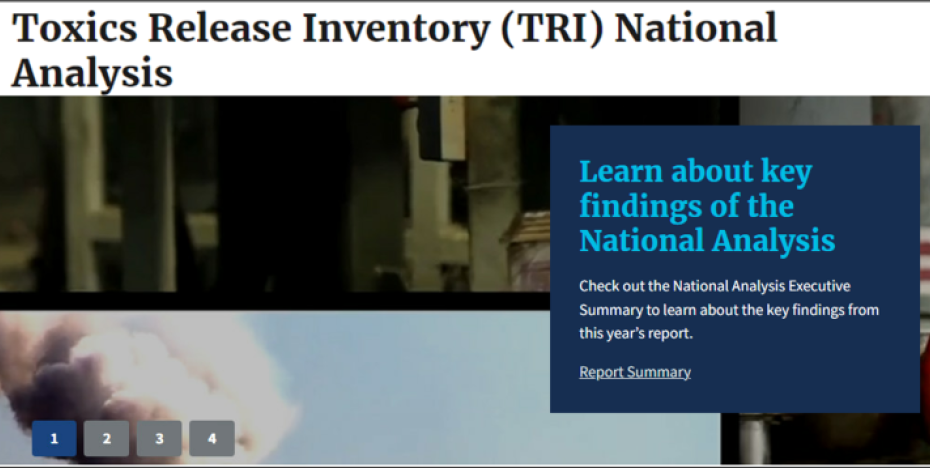Welcome!
This executive summary presents an overview of EPA’s most recent Toxics Release Inventory (TRI) data, based on the detailed information found in EPA's TRI National Analysis website. Congress established the TRI to ensure that every community is empowered with access to information on the toxic chemicals handled and released at nearby facilities. The TRI includes annual data submitted by industry on how chemical wastes are managed, including those that are released to the environment.
The TRI National Analysis is EPA’s presentation of the most recent data.
The National Analysis is part of EPA’s commitment to transparency and enhances public understanding of the TRI data by:
- Summarizing reported data on releases and other waste management practices of toxic chemicals, and providing trend analyses of these data; and
- Providing interactive tools that support access to and exploration of TRI data.
- Visit the full TRI National Analysis to learn more.
21,752 facilities reported to TRI for 2022.
Facilities in industry sectors such as manufacturing, electric power generation, and mining have until July 1 of each year to submit data from the previous calendar year. These data then undergo quality reviews by EPA. Use this map to see the TRI information submitted by individual facilities.
View TRI data by state, metro area, watershed, tribe or community
The TRI National Analysis includes the option to view the TRI data for a specific area including by state, community, tribal community, or watershed. When zoomed in to a community profile, the map displays the TRI facility locations (each blue dot represents a TRI facility) and a shaded background that shows information on the demographics of the location. Explore your area by selecting the “Community Profile” option in the Where You Live tool of the TRI National Analysis.
Since 2013, releases to the environment have decreased by 21%, with reductions across all media.
- For 2022, TRI facilities reported 3.3 billion pounds of releases to air, water, and land.
- Land disposal, largely from metal mining, accounted for 64% of releases.
- From 2021 to 2022, releases of TRI chemicals increased by 1% (45 million pounds).
- Learn more about releases reported to TRI (link opens in a new tab or browser window).
Long-term declines in air emissions reported to TRI are one driver of decreased total releases.
- Air releases decreased by 26% (204 million pounds) from 2013 to 2022.
- Almost all sectors reduced their air emissions since 2013, with the largest reduction coming from the electric utilities sector.
- Air emission reductions by electric utilities were largely due to: decreased emissions of hydrochloric acid and sulfuric acid; a shift from coal to other fuel sources (e.g., natural gas); and the installation of control technologies at coal-fired power plants.
- Releases to air of ammonia, methanol and sulfuric acid accounted for almost half of all air emissions reported to TRI for 2022.
- Learn more about air emissions reported to TRI (link opens in a new tab or browser window).
88% of the TRI chemical waste that facilities managed was not released due to preferred waste management practices such as recycling.
- In addition to quantities released, facilities report the quantities of TRI-listed chemicals that they manage through preferred methods including recycling, combusting for energy recovery, and treatment.
- Since 2013, waste managed increased by 2.0 billion pounds (7%), driven by increased recycling.
- Learn more about waste management practices reported to TRI (link opens in a new tab or browser window).
TRI facilities implemented 3,589 new source reduction activities in 2022 to reduce pollution at its source.
- Source reduction success stories presented in the National Analysis highlight effective practices that other facilities can replicate. EPA's TRI Pollution Prevention (P2) Search Tool (link opens in a new tab or browser window) promotes these opportunities for knowledge transfer by allowing users to search for source reduction activities that might be relevant to their operations.
- The figure summarizes the most frequently reported source reduction activities for the chemicals and industry sectors with the highest source reduction reporting rates over the last 5 years. Facilities most commonly reported Process and Equipment Modifications – such as optimizing process conditions to increase efficiency, and improvements to Operating Practices and Training – such as changing production schedules to minimize equipment changeovers.
- Learn more about source reduction activities reported to TRI (link opens in a new tab or browser window).
Each year, the TRI National Analysis examines key industry sectors.
Choose from the industry sectors to the right to learn more about their TRI releases.
- For 2022, 19,215 manufacturing facilities reported to TRI, which is 88% of all TRI-reporting facilities for the year.
- Since 2013, releases by manufacturing facilities decreased by 9%. This is primarily due to reductions in air releases and on-site disposal to land.
- Manufacturing facilities reported initiating more than 3,400 new source reduction activities during 2022 to reduce TRI chemical use and waste generation.
- Learn more about sector-level TRI reporting (link opens in a new tab or browser window).


Social Media
Use the share button at the top to share this report with others and follow the latest EPA activities to protect human health and the environment.
Contact Us (link opens in a new tab or browser window) to ask a question, provide feedback, or report a problem.